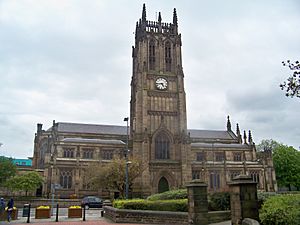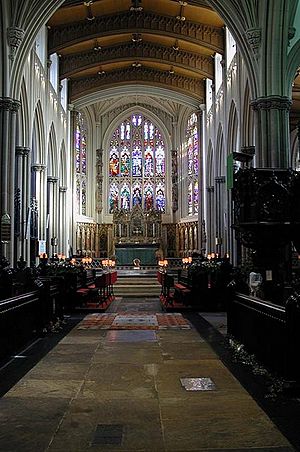Leeds Minster facts for kids
Quick facts for kids Leeds Minster |
|
|---|---|
| Minster and Parish Church of St Peter-at-Leeds | |

The Minster and Parish Church of Saint Peter-at-Leeds
|
|
| 53°47′42″N 1°32′10″W / 53.79500°N 1.53611°W | |
| OS grid reference | SE 30658 33301 |
| Country | England |
| Denomination | Church of England |
| Churchmanship | Broad church |
| History | |
| Dedication | St Peter |
| Architecture | |
| Architect(s) | Robert Chantrell |
| Specifications | |
| Length | 55 metres (180 feet) |
| Tower height | 42 metres (139 feet) |
| Bells | 12 + flat 6th |
| Tenor bell weight | 40 long cwt 1 qr 27 lb (4,535 lb or 2,057 kg) |
| Administration | |
| Parish | Leeds City |
| Deanery | North-west Leeds |
| Archdeaconry | Leeds |
| Episcopal area | Leeds |
| Diocese | Leeds |
| Province | York |
Leeds Minster, also called the Minster and Parish Church of Saint Peter-at-Leeds, is a very important church in Leeds, West Yorkshire, England. It stands where the oldest church in the city once was. A church has been on this spot since the 7th century! The building you see today was finished in 1841. It was designed by Robert Dennis Chantrell in a style called Gothic Revival. The church is dedicated to Saint Peter. It was known as Leeds Parish Church until 2012, when it was given the special title "Minster." It is also a Grade I listed building, which means it's a very important historical site.
Contents
History of the Minster Building
Early Churches on the Site
A church in Ledes was mentioned in the Domesday Book in 1086. But there was likely a church here much earlier. Pieces of old stone crosses from the Anglo-Saxon period were found when the current church was being built. These crosses show that a church stood here long before 1086.
Rebuilding the Church
The church was rebuilt twice over the years. Once was after a fire in the 14th century. The second time was in the 19th century. Walter Farquhar Hook, who was the Vicar of Leeds from 1837, helped make the current building happen. He also worked to make the Anglican church stronger across Leeds.
A New Design for a Growing City
At first, people only wanted to make the old church bigger. They planned to move the tower and widen parts of the church. But when construction started, they found that the old building was in bad shape. So, they decided to build a completely new church instead.
The new church was the largest new church built in England since Sir Christopher Wren's St Paul's Cathedral in London. The people of Leeds raised over £29,000 to pay for it. The new church was officially opened on September 2, 1841. Famous people like Florence Nightingale were there. The organ was played by Dr Samuel Sebastian Wesley.
Becoming Leeds Minster
The church became Leeds Minster in a special ceremony on September 2, 2012. This was exactly 171 years after the new building was first opened. Leeds Minster is one of three minster churches in West Yorkshire. The others are Dewsbury Minster and Halifax Minster.
The Church's Surroundings
The Parish of Leeds
The original parish of Leeds was very large. It covered an area of 21,000 acres! Many smaller towns and villages were part of it. Over time, these places built their own smaller churches. This saved people from having to travel far to the main parish church.
In the 19th century, many new churches were built across the parish. This helped to serve the growing population of Leeds.
Architecture and Design
Building Style and Size
Leeds Minster is shaped like a cross when you look at it from above. It is built from stone with slate roofs. The style looks like English Gothic architecture from the late 1300s. This was a time when church designs were changing.
The church is about 55 meters (180 feet) long and 26 meters (86 feet) wide. Its tower reaches up to 42 meters (139 feet) high. The main entrance is on the north side, under the tower. The tower has four levels and strong corner supports. It also has fancy turrets and battlements at the top. The clock was made by a company called Potts of Leeds.
Inside the Minster
Windows and Decorations
The windows have beautiful patterns called Perpendicular tracery. The large east window, from 1846, has glass collected from different places in Europe. The area around the altar has marble arches and colorful mosaics. These were made by Salviati of Venice. The decorative screen behind the altar is made of marble and alabaster.
Bells and Organ
The church has a set of 13 bells. They were first made in 1842 and then remade in 1932. The largest bell weighs over 40 long tons!
The organ is very old and special. Parts of it date back to 1841. It was mostly built by Harrison and Harrison in 1914. It has been repaired and updated several times since then.
Treasures and Memorials
Inside the Minster, you can find many interesting items. One of the most important is the Leeds Cross. These are pieces of an Anglo-Saxon cross found in 1838.
There is also a special plaque remembering Captain Oates. He was a brave explorer who went on Scott's Antarctic expedition. He had connections to Leeds. The church also has beautiful Flemish stained glass. A newer piece is the Angel Screen from 1997. It is a modern example of glass engraving.
Outside the church, you can see the Leeds Rifles War Memorial. It was designed by Sir Edwin Lutyens and was unveiled in 1921.
Leeds Minster Today
Leeds Minster is part of the Anglican Diocese of Leeds. It is located at the eastern edge of the city center. It is near some of Leeds's oldest streets, like Kirkgate.
The Reverend Canon Paul Maybury became the leader of the church in December 2022.
The church helps young people through a drop-in center called The Market Place.
Music at the Minster
Leeds Minster has a long history of great music. The church has a choir of adult singers and students from local universities. They sing at services several times a week.
There are also weekly organ recitals on Fridays at 1 PM. These feature the church's own organists and guest musicians.
Famous Organists
Many talented organists have played at Leeds Minster. Some famous ones include:
- Samuel Sebastian Wesley (1842–1849)
- Dr Edward Bairstow (1906–1913)
- Dr Donald Hunt OBE (1957–1975)
- Dr Simon Geoffrey Lindley (1975–2016)
The current Organist and Director of Music is Alexander Woodrow.
Samuel Sebastian Wesley's 200th Anniversary
In 2010, the Minster celebrated the 200th birthday of Samuel Sebastian Wesley. He was a very important organist and composer who worked at the church. There were special concerts and services to mark the occasion.
Graveyard
The church used to have a graveyard across the Kirkgate road. Burials stopped there in the 1830s. That land is now a park called Penny Pocket Park.
Rugby League Connection
A rugby league team from Leeds Parish Church joined a major rugby league group in 1896. The team played for five seasons before stopping in 1901.
See also
- Grade I listed churches in West Yorkshire
- Listed buildings in Leeds (City and Hunslet Ward - southern area)


